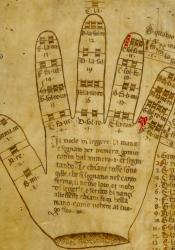Creation of the Staff Notation and Guidonian Hand
In 1025, Guido D’Arezzo revolutionized musical notation by creating the four-lined staff, a primitive form of notation that eventually led to the development of the five-lined staff notation still used in modern music today. This development in musical notation was intended to make it easier for individuals to learn, understand, and memorize new compositions; it was also one of the first movements taken in the process of creating a universal standard for written music. In addition to the four-lined staff, Guido is also credited with constructing the Guidonian Hand (more commonly known as the “do-re-mi-fa” mnemonic system), another musical technique used to make the learning of music easier. With both methods, performers were able to associate sound with sight and become more familiar with pitch and mode.
Sources:
-
Reisenweaver, Anna J. (2012) "Guido of Arezzo and His Influence on Music Learning," Musical Offerings: Vol. 3 : No. 1 , Article 4. DOI: 10.15385/jmo.2012.3.1.4 Available at: http://digitalcommons.cedarville.edu/musicalofferings/vol3/iss1/4
Image Source: Oxford University, via Wikimedia Commons

